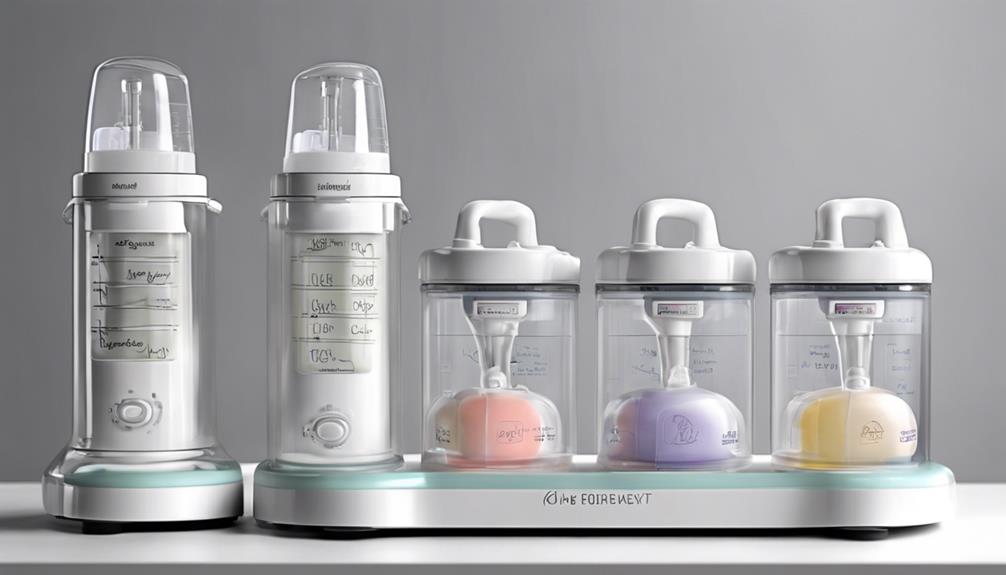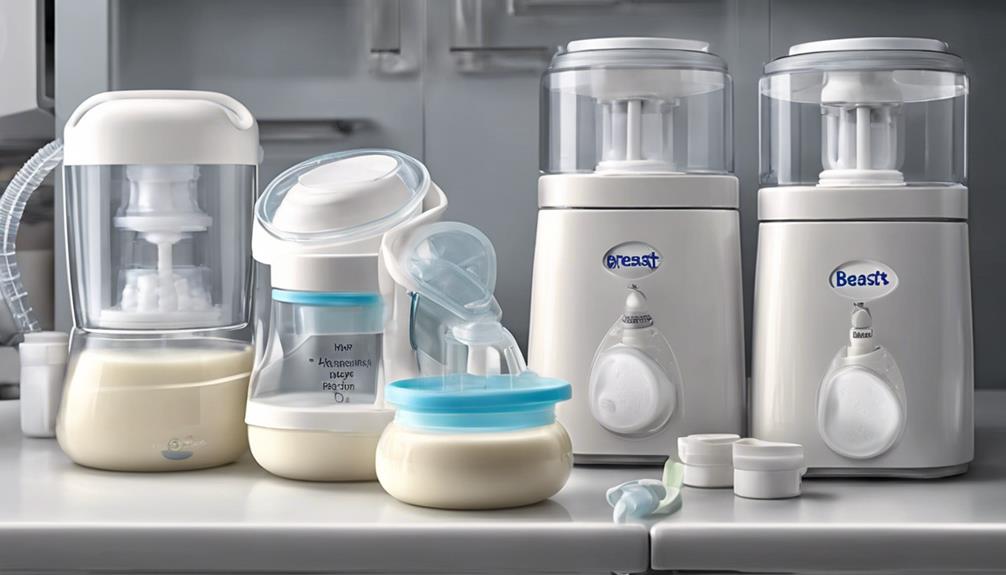Have you thought about how making small adjustments to your pumping routine could significantly impact your milk supply, ultimately leading to successful formula feeding?
Understanding the nuances of pump settings, flange fit, and relaxation techniques are just the beginning of our journey toward optimizing milk output.
Join us as we explore practical tips and strategies to enhance your pumping experience and achieve your formula feeding goals with ease and effectiveness.
Key Takeaways
- Choose a pump that suits your needs and supports formula feeding.
- Establish a consistent pumping routine to maintain milk production.
- Maximize pumping efficiency with double electric pumps and hands-on techniques.
- Properly store and handle pumped milk for formula feeding convenience.
Choosing the Right Pump
When selecting a breast pump for efficient pumping, it's important to contemplate factors such as suction strength, portability, and noise level to meet your specific needs.
For those looking to establish or maintain a healthy milk supply, the right pump can make a significant difference. Hospital-grade pumps are often recommended for exclusive pumpers or individuals needing to boost their milk production. These pumps are designed to mimic a baby's sucking pattern, which can be beneficial for stimulating milk supply effectively.
On the other hand, personal electric pumps offer adjustable settings that cater to different comfort levels and pumping needs. This flexibility can be advantageous for maintaining a consistent milk supply over time. Understanding how different pump options can impact your milk production is essential when deciding which pump will best support your breastfeeding journey.
Establishing a Pumping Routine

To establish a successful pumping routine, consistency in timing and length is key to maintaining a steady milk supply and preventing engorgement. Time for nursing mothers is precious, and dedicating regular intervals for pumping can make a significant difference in your breastfeeding journey.
Here are three essential tips to help you establish an effective pumping routine:
- Follow a Regular Schedule: Aim to pump every 2-3 hours, including overnight, to mimic a baby's feeding pattern. This consistency signals your body to continue producing milk and helps prevent engorgement.
- Pump for Best Duration: Pump for about 15-20 minutes per session to fully empty the breasts and maximize milk production. This duration allows for efficient milk removal, stimulating your body to produce more milk for your baby.
- Incorporate Hands-On Techniques: Utilize hands-on pumping techniques like breast massage and compression to enhance milk flow. These methods can help stimulate multiple milk ducts simultaneously, leading to increased milk output.
Maximizing Pumping Efficiency
Establishing a successful pumping routine lays the foundation for maximizing efficiency in milk production for formula feeding. To keep your breast milk supply steady and meet the demands of formula feeding, it's essential to optimize your pumping sessions. Using a double electric breast pump can save time and help increase milk output efficiently. Pumping at least 8-12 times a day, including overnight sessions, can ensure you're meeting the needs of formula feeding. Implementing hands-on pumping techniques like breast compression can enhance milk flow and thoroughly empty your breasts during each session. Consistency is key in maximizing pumping efficiency; maintaining a regular pumping schedule, even on weekends, supports long-term milk production for successful formula feeding. Remember, the more effectively you empty your breasts during pumping, the better your milk supply will be for formula feeding.
| Maximizing Pumping Efficiency | Tips for Success |
|---|---|
| Utilize a double electric breast pump | Saves time and increases milk output |
| Pump at least 8-12 times a day | Ensures optimal milk production for formula feeding |
| Use hands-on pumping techniques | Improve milk flow and emptying during sessions |
Storing and Handling Pumped Milk

For best storage and handling of pumped milk, it's crucial to use clean containers with tight lids to maintain its quality and prevent contamination. When storing your precious breast milk, consider the following:
- Refrigerate Promptly: After expressing milk, refrigerate it promptly to safeguard its nutrients and freshness. This helps in preserving the quality of the milk for your little one in the time to come.
- Label with Date: To guarantee proper rotation and use, always label pumped milk with the date it was expressed. This practice helps you use the oldest milk first and prevents any waste.
- Thaw Carefully: When thawing frozen breast milk, do so in the refrigerator or under warm running water. Avoid using the microwave as it can create hot spots that may harm the milk's beneficial properties. Taking care in the thawing process will make sure that your stored milk remains safe for your baby in the time to come.
Troubleshooting Pumping Challenges
When encountering pumping challenges, it's important to troubleshoot effectively to optimize milk expression and maintain a healthy milk supply. Check your pump settings and confirm the correct flange size for best milk output.
Proper breast shield placement is essential to prevent discomfort and maximize milk expression. If you experience suction issues, inspect your pump parts for wear and tear and replace them as needed. Consistency in your pumping schedule is key to establishing and preserving your milk supply for bottle feeding.
If you're facing persistent challenges, don't hesitate to seek guidance from a lactation consultant. These professionals can provide personalized support and offer valuable troubleshooting tips to enhance your pumping experience. Remember, troubleshooting pumping issues is a normal part of the process, and with the right adjustments and support, you can overcome these challenges and continue providing your baby with the nourishment they need through bottle feeding.
Frequently Asked Questions
How Often Should You Pump When Formula Feeding?
We pump based on our comfort and milk supply needs. Some mimic breastfeeding frequency, while others pump 2-3 times daily. Adjust your schedule as needed for well-being. Remember, it's about what works best for us.
Is It OK to Just Pump and Not Breastfeed?
Absolutely, it's okay to just pump and not breastfeed if that's what works for you. Many parents find exclusive pumping to be a fulfilling choice. It's important to prioritize what's best for you and your baby.
Do Babies Still Benefit From Pumped Breast Milk?
Yes, babies benefit greatly from pumped breast milk. It provides essential nutrients, antibodies, and immune factors for best growth and development. Pumped milk retains its nutritional value, supports the immune system, and fosters a strong bond between parent and baby.
Will Pumping Every 30 Minutes Increase Supply?
Pumping every 30 minutes may not greatly increase milk supply. Focus on quality over frequency. Consult with a lactation consultant for personalized advice. Balance pumping with rest for best milk production. Prioritize self-care for overall well-being.
Conclusion
As we journey through the world of efficient pumping for formula feeding success, let's remember that we're like the conductors of a symphony orchestra, orchestrating each pump session with care and precision.
By following the right strategies and seeking support when needed, we can secure a harmonious flow of milk production and feeding for our little ones.
Let's continue to nurture and support each other on this beautiful journey of parenthood.









